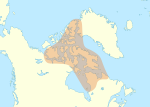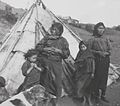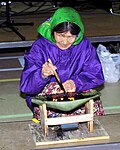The Paleo-Eskimo meaning "old Eskimos", also known as, pre-Thule or pre-Inuit, were the peoples who inhabited the Arctic region from Chukotka (e.g., Chertov...
13 KB (1,598 words) - 06:25, 20 October 2024
in which they implored scientists to use Inuit and Paleo-Inuit instead of Eskimo or Paleo-Eskimo. In a 2015 commentary in the journal Arctic, Canadian...
72 KB (7,023 words) - 14:09, 27 October 2024
The Early Paleo-Eskimo is the first of three distinct periods of human occupation recognized by archaeologists in the eastern North American Arctic, the...
2 KB (178 words) - 13:31, 14 September 2022
Dorset culture (redirect from Dorset Eskimo)
The Dorset was a Paleo-Eskimo culture, lasting from 500 BCE to between 1000 CE and 1500 CE, that followed the Pre-Dorset and preceded the Thule people...
19 KB (1,696 words) - 07:43, 18 November 2024
from Siberia, the Paleo-Eskimo people 4,500 years ago and the Thule people 1,000 years ago. The Inuit dogs from Canada (Canadian Eskimo Dog) and Greenland...
25 KB (2,763 words) - 01:40, 19 October 2024
larger and may have housed extended families. The Dorset people continued Paleo-Eskimo traditions, such as using toggling harpoons and kept a small breed of...
10 KB (1,497 words) - 23:21, 17 October 2023
ivory, dating from early Paleo-Eskimo and from early Dorset culture period. Despite some similarities in the cultures of the Eskimo peoples, their cultural...
10 KB (963 words) - 22:21, 7 February 2024
000 YBP, and later gave rise to migrants into America." The ancient Paleo-Eskimo peoples were probably involved in these migrations. Prehistory of Siberia...
5 KB (486 words) - 02:39, 23 May 2024
the Saqqaq settlement, the site of many archaeological finds) was a Paleo-Eskimo culture in southern Greenland. Up to this day, no other people seem to...
8 KB (642 words) - 03:53, 12 May 2024
about 20,000 years ago. Arctic Canada and Greenland were reached by the Paleo-Eskimo expansion around 4,000 years ago. Finally, Polynesia was populated within...
112 KB (11,997 words) - 09:24, 21 November 2024
Thule people (redirect from Neo-Eskimo)
ancestors of the Thule emerged in Alaska through admixture between the Paleo-Eskimo and the Ocean Bay Tradition and that these ancestors subsequently migrated...
30 KB (3,685 words) - 23:45, 6 August 2024
Dorset culture, called the Tuniit in Inuktitut, which was the last major Paleo-Eskimo culture. Inuit legends speak of the Tuniit as "giants", people who were...
130 KB (13,696 words) - 19:50, 30 October 2024
Independence I was a culture of Paleo-Eskimos who lived in northern Greenland and the Canadian Arctic between 2400 and 1900 BC. There has been much debate...
23 KB (2,875 words) - 21:59, 9 November 2024
American groups. According to this study, the Yeniseians are linked to the Paleo-Eskimo groups. The ancestors of Yeniseian peoples may have been related to the...
21 KB (2,361 words) - 23:07, 30 October 2024
Pre-Dorset (category Eskimos)
The Pre-Dorset is a loosely defined term for a Paleo-Eskimo culture or group of cultures that existed in the Eastern Canadian Arctic from c. 3200 to 850...
10 KB (1,263 words) - 17:02, 6 April 2024
years ago, people and their dogs did not settle in the Arctic until the Paleo-Eskimo people 4,500 years ago, followed by the Thule people 1,000 years ago...
17 KB (1,910 words) - 07:23, 17 November 2024
Independence II was a Paleo-Eskimo culture that flourished in northern and northeastern Greenland from around 700 to 80 BC, north and south of the Independence...
3 KB (308 words) - 06:05, 13 November 2024
within the Paleo-Siberian group have been made by some scholars, including Edward Vajda, who suggests them to be related to the Na-Dené and Eskimo–Aleut families...
16 KB (1,140 words) - 01:12, 21 May 2024
means 'Land of the Fish'. The first inhabitants of Newfoundland were the Paleo-Eskimo, who have no known link to other groups in Newfoundland history. Little...
49 KB (5,355 words) - 12:19, 23 October 2024
(Chukot: копалгын, romanized: kopalgyn, IPA [kopaɬɣən]) is an Early Paleo-Eskimo, autolysis-based method of preparing and preserving meat, particularly...
2 KB (246 words) - 00:16, 19 November 2024
Greenlandic Inuit (redirect from Greenlandic Eskimos)
JSTOR 24475839. S2CID 162882708. Outram, Alan K. (1999). "A Comparison of Paleo-Eskimo and Medieval Norse Bone Fat Exploitation in Western Greenland" (PDF)...
17 KB (1,587 words) - 19:58, 28 October 2024
lasted until approximately 3500 BC, corresponding with the arrival of the Paleo-Eskimo groups who may have outcompeted the Maritime Archaic for resources[citation...
8 KB (925 words) - 03:51, 13 November 2024
peninsula, where it was in cultural contact with the Eskimo–Aleut language speakers, and the Paleo-Eskimos. A ceramic complex comparable to the Ymyyakhtakh...
5 KB (473 words) - 19:37, 19 October 2024
North America (Alaska), leading to the Settlement of the Americas. Early Paleo-Eskimo groups included the Pre-Dorset (c. 3200–850 BC); the Saqqaq culture of...
65 KB (6,990 words) - 15:08, 12 August 2024
It is suggested that by 4000–3000 BCE Paleo-Eskimo peoples began coming to the Americas from Siberia. Eskimo tribes live today in both Asia and North...
7 KB (889 words) - 19:20, 10 July 2023
American groups. According to this study, the Yeniseians are linked to the Paleo-Eskimo groups. The Kets are thought to be the only survivors of an ancient nomadic...
22 KB (2,379 words) - 04:25, 24 October 2024
several years of poor conditions, Paleo-Eskimos disappear from the archaeological record about 3500 years ago. Dorset Eskimos are known over a span of 1500...
8 KB (1,210 words) - 01:42, 26 September 2023
assimilated local Yeniseian people which were closely related to the Paleo-Eskimo groups. From the 13th to 18th century, the Altai people were dominated...
38 KB (3,800 words) - 05:10, 20 November 2024
Tuniit in Inuktitut, which was the last major Paleo-Eskimo culture. The first Inuit group, known as Paleo-Eskimos, crossed the Bering Strait in 3000 BCE presumably...
100 KB (13,378 words) - 19:29, 30 October 2024
; Khrameeva, Ekaterina E. (2016-02-11). "Genomic study of the Ket: a Paleo-Eskimo-related ethnic group with significant ancient North Eurasian ancestry"...
8 KB (744 words) - 05:25, 24 October 2024




















